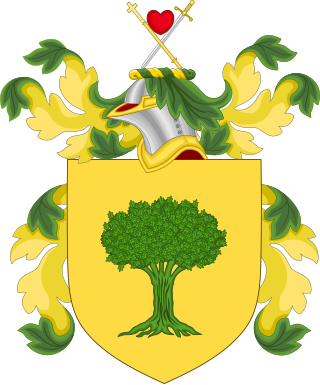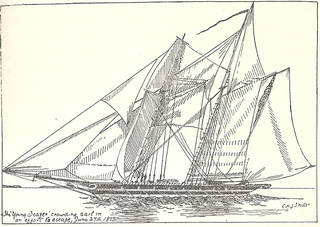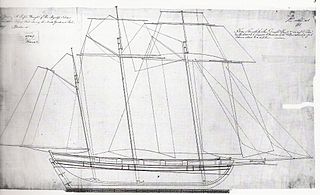HMS Sceptre was a 74-gun third rate of the Royal Navy, built by Dudman of Deptford after a design by Sir William Rule, and launched in December 1802 at Deptford. She served in the Napoleonic Wars and the War of 1812 before being broken up in 1821.

Thomas Boyle, an Irish American, as a captain of the schooner Comet and the clipper Chasseur, was one of the most successful Baltimore privateers during the War of 1812. He briefly served in the United States Navy during the same war.

Chasseur was a Baltimore Clipper commanded by Captains Pearl Durkee, William Wade (1813) and Thomas Boyle (1814-1815). She was one of the best equipped and crewed American privateers during the War of 1812.

HMS Poictiers was a 74-gun Royal Navy third rate. This ship of the line was launched on 9 December 1809 at Upnor. During the War of 1812 she was part of the blockade of the United States. She was broken up in 1857.

HMS Acasta was a 40-gun Royal Navy fifth-rate frigate. She saw service in the French Revolutionary and Napoleonic Wars, as well as the War of 1812. Although she never took part in any notable single-ship actions nor saw action in a major battle though she was at the Battle of San Domingo, she captured numerous prizes and rid the seas of many Spanish, French and American privateers. She was finally broken up in 1821.

Young Teazer was a United States privateer schooner that captured 12 British vessels, five of which made it to American ports. A member of her crew blew her up at Mahone Bay, Nova Scotia during the War of 1812 after a series of British warships chased her and after HMS Hogue trapped her. The schooner became famous for this deadly explosion, which killed most of her crew, and for the folklore about the ghostly "Teazer Light."
HMS Highflyer was originally an American privateer schooner built in 1811. As a privateer she took several British vessels as prizes. The Royal Navy captured her in 1813. She then participated in several raids on the Chesapeake and coastal Virginia before the Americans recaptured her later in 1813.
HMS Anaconda was an 18-gun brig-sloop of the Royal Navy during the War of 1812. She was cruising as an American privateer until sailors from HMS Sceptre captured her in 1813. She served briefly in the Royal Navy during the later stages of the War of 1812, especially at the Battle of New Orleans, before being sold in Jamaica in 1815.
HMS Landrail was a Cuckoo-class schooner built by Thomas Sutton at Ringmore, Teignmouth. Like all her class she carried four 12-pounder carronades and had a crew of 20. She had a relatively uneventful career during the Napoleonic Wars and the War of 1812 until 1814 when she was taken in a notable action, and then retaken. She was sold in approximately 1818.
HMS Laura was an Adonis-class schooner of the Royal Navy, launched in 1806 at Bermuda. Laura served during the Napoleonic Wars before a French privateer captured her at the beginning of the War of 1812. She was briefly an American letter of marque before the British recaptured her in 1813. Despite having recaptured her, the British did not return Laura to service.

HMS Emulous was a Royal Navy 18-gun Cruizer-class brig-sloop, built by William Row at Newcastle and launched in 1806. She survived an inconclusive but bloody battle with a French frigate during the Napoleonic Wars and captured a number of prizes, including two privateers, on the Halifax station during the War of 1812 before she was wrecked in 1812.
HMS Colibri was the French naval Curieux-class brig Colibri, launched in 1808, that the British captured in 1809 and took into the Royal Navy under her existing name. She spent her time in British service on the North American station based in Halifax, Nova Scotia. During the War of 1812, Colibri served mostly in blockading the American coast and capturing privateers and merchant ships. She foundered in 1813 in Port Royal Sound, South Carolina, but without loss of life.

HMS Superieure was the French privateer Supérieure, which was built in 1801 in Baltimore, Maryland, and which the British captured in 1803 in the West Indies, and took into the Royal Navy. She spent most of her career on the Jamaica and Leeward Islands stations, where she captured numerous privateers. She participated in several notable single-ship actions, including one in which she harassed a frigate, and two campaigns that would, in 1847, earn her surviving crew members the Naval General Service Medal (NGSM). She was laid-up in Britain in 1810 and sold in 1814.

HMS Flying Fish was the American-built schooner Flying Fish, launched in 1801. She became the French privateer schooner Poisson Volant, which the British captured in 1803 in the West Indies and took into the Royal Navy. She captured a privateer and recaptured some small merchant vessels. She was renamed Firefly in 1807, but was lost with all hands when she foundered later that year.
HMS Netley was launched in 1798 with an experimental design. During the French Revolutionary Wars she spent some years on the Oporto station, where she captured many small privateers. The French captured her in 1806, early in the Napoleonic Wars. They lengthened her and she became the 17-gun privateer Duquesne. In 1807 the British recaptured her and the Royal Navy returned her to service as the 12-gun gun-brig HMS Unique. She was expended in an unsuccessful fire ship attack at Guadeloupe in 1809.
HMS Atalanta was the American letter of marque schooner Siro, launched in 1812, that the British captured in 1814. There is no evidence that she actually entered into active service with the Royal Navy. She was a merchant brig when the USS Wasp captured her in September 1814 and sent her into Savannah as a prize, where she was condemned and sold.
Pursuit was launched at Whitby in 1795. She made two voyages for the British East India Company and then traded with the West Indies. She repelled one attack by a French privateer that caused severe casualties, but eventually an American privateer captured her in August 1812.

Comet, an American schooner, was built in 1810 at Baltimore, Maryland. She was owned by "a group of wealthy Baltimore investors." Under Captain Thomas Boyle, who was a part owner of the schooner, Comet sailed from July 1812 to March 1814 as a privateer, which was a type of ships licensed by the United States during the War of 1812 to harass the British merchant vessels and divest their cargoes.
HMS Barbadoes was a 16-gun vessel, the American Herald, captured in 1813. The Royal Navy took her into service as HMS Barbadoes She captured a number of merchantmen and privateers before she was paid-off in May 1816. In 1814–1815 she also captured three Spanish and French slave ships carrying over 1100 enslaved people. Barbadoes became a powder ship in Jamaica that was later wrecked with her remains being sold.
HMS Columbia was the United States privateer brig Curlew, which the British Royal Navy captured in 1812 and took into service as HMS Columbia. The Navy sold her in 1820.









